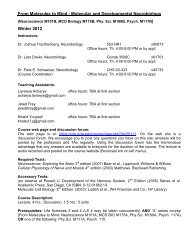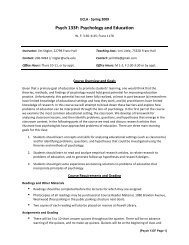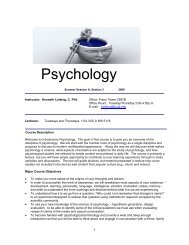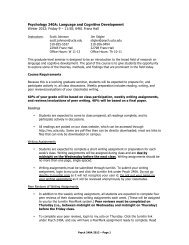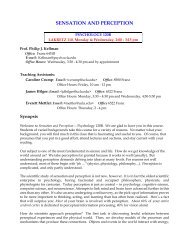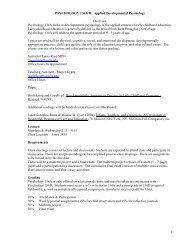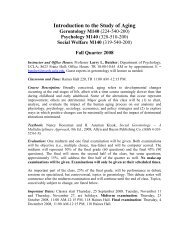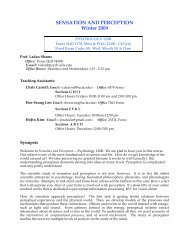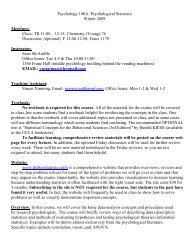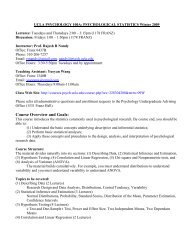Syllabus - Courses in Psychology - UCLA
Syllabus - Courses in Psychology - UCLA
Syllabus - Courses in Psychology - UCLA
You also want an ePaper? Increase the reach of your titles
YUMPU automatically turns print PDFs into web optimized ePapers that Google loves.
About reference lists: we do not need one for this paper. We will assume that you havebeen read<strong>in</strong>g the textbook, and that it <strong>in</strong>forms your th<strong>in</strong>k<strong>in</strong>g for this paper. That is the wholepo<strong>in</strong>t, so don’t worry about citations and bibliographies. Just expla<strong>in</strong> an experience and showhow much you know.Due DateAll papers must be pr<strong>in</strong>ted out and submitted through TurnItIn by 10:00 AM on Mondayof Week 8 of the course. No late papers will be accepted. Seriously, the web site will not let yousubmit a late paper, so do not even th<strong>in</strong>k about it. That web site is cold, man.How to Submit through Turn-It-In:Step 1. Log onto My<strong>UCLA</strong> and scroll down to your Study List for the current termStep 2. Click on the “TurnItIn” l<strong>in</strong>k for the class. This l<strong>in</strong>k will take you directly to yourclass portfolio page on the TurnItIn.com websiteStep 3. Click on the “submit” icon for the assignment you wish to turn <strong>in</strong> and the“submit” w<strong>in</strong>dow will open for that specific assignmentStep 4. You can upload your file as a Word document.Step 5. Click Submit. After you click submit, a new w<strong>in</strong>dow will open display<strong>in</strong>g yourdigital receipt. Your digital receipt is the confirmation that your submission has beensuccessfully completed.Tips on Writ<strong>in</strong>gWrit<strong>in</strong>g brief essays is challeng<strong>in</strong>g, and you should approach the paper with this <strong>in</strong> m<strong>in</strong>d.Try to write as efficiently as possible. You want to be clear, but at the same time don't wastespace by us<strong>in</strong>g unnecessary words to make a po<strong>in</strong>t or by talk<strong>in</strong>g about someth<strong>in</strong>g that isn't reallyrelevant to your argument. Do<strong>in</strong>g so will prevent you from mak<strong>in</strong>g important arguments ordescrib<strong>in</strong>g someth<strong>in</strong>g more fully <strong>in</strong> another section of the paper, and thereby hurt<strong>in</strong>g your grade.One way to approach these papers is to write a draft and then revise it repeatedly, edit<strong>in</strong>g it untilit is concisely and clearly written. If you are uncerta<strong>in</strong> about what you have written, have a friendread your writ<strong>in</strong>g first. Then have your friend tell you what your paper is about. If your frienddoes not understand your paper, you have some revis<strong>in</strong>g to do.One purpose of the paper assignment is for your TA to see how well you understandmaterial from lecture and read<strong>in</strong>gs and how well you can apply that material. Therefore, the<strong>in</strong>formation from class and from the book represents the "build<strong>in</strong>g blocks" that you should use <strong>in</strong>construct<strong>in</strong>g your paper. In other words, BUILD YOUR PAPER AROUND COURSEMATERIAL! Use as much <strong>in</strong>formation as possible from lectures and read<strong>in</strong>gs to support yourideas <strong>in</strong> the papers. Use the paper to demonstrate that you have understood the lectures, read thetext, and can effectively apply the material to a problem.page 11



